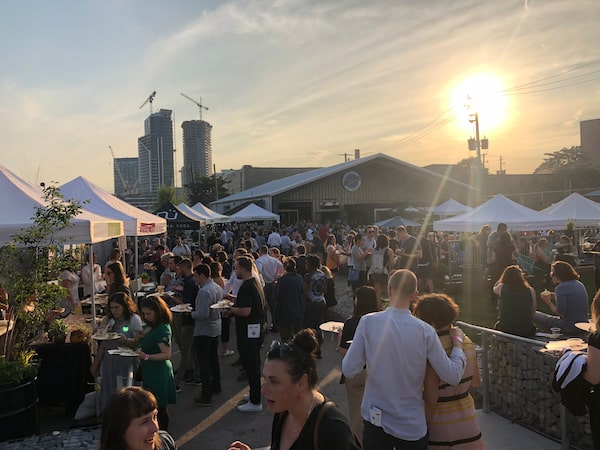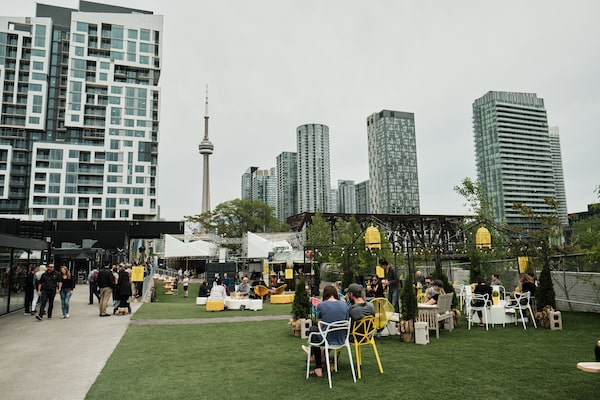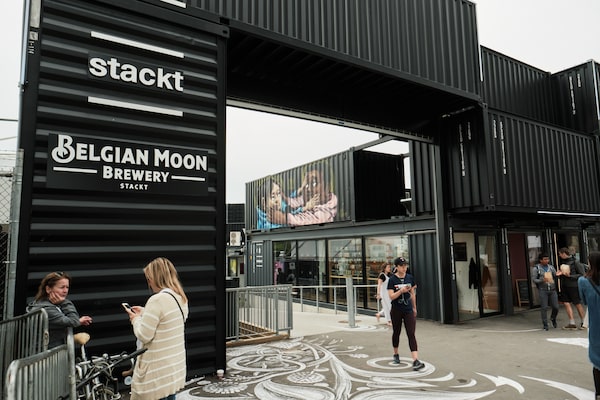
Stackt Market, the long-anticipated modular market in downtown Toronto, opened its doors to the public in April, unveiling dozens of new retail, food, beverage, service, experience and community spaces within roughly 120 shipping containers.Matt Rubinoff/Supplied
On any given weekend, close to Bathurst and Front Streets in downtown Toronto, you’ll find a block-long line of people taking shape. Even early in the morning, the line consists of urbanites, hipsters and tourists – all waiting patiently for donuts. Not just any deep-fried dessert with a hole in the middle, mind you. We are talking about gourmet creations – in flavours such as Lemon Lavender and Brown Butter Walnut – from Hamilton’s Donut Monster.
So, why would a successful Hamilton donut shop choose to open near Toronto’s King West area? The promise of brisk business, for one, but also because Donut Monster is one of approximately 40 hand-picked vendors invited to set up shop as part of Canada’s latest and largest shipping-container modular marketplace.
It’s called Stackt Market (or simply ‘Stackt’) and it is, quite easily, one of the coolest new public spaces in one of the fastest growing neighbourhoods in this already massive city.
Container space brings business buzz
With 120 shipping containers occupying 100,000 square feet of land owned by the City of Toronto, Stackt Market officially opened on April 10. The lease will be in effect until September, 2020, although there is hope for an extension as residents and city hall become increasingly aware of the benefits of this one-of-a-kind curated space.
Not too long ago, the 2.5-acre patch of vacant land that Stackt now occupies sat derelict, waiting for someone with the right vision to give it new life. When the parcel eventually became available, founder Matt Rubinoff went to work, bringing life to his vision of a container space where the community could gather, connect and share experiences.

Designed entirely out of shipping containers, Stackt offers a new outdoor all-season retail experience for both retailers and their clients.PATRICK LEUNG/Supplied
Five years later, Stackt is now a thriving King West hot spot, complete with free WiFi, dog-friendly greenspace and a revolving door of trendy retailers. Given its resounding success, Mr. Rubinoff would love to take the container market concept to other neighbourhoods.
“If the lease is not renewed, you could pick up everything and move it to another site,” he says. “Although, we are hoping the community embraces the project and we get the opportunity to stay longer.”
Shipping containers open up new spots around the world
For years, Mr. Rubinoff lived close by, at Tecumseh and Richmond Streets, in Toronto’s still-developing west end. He knew the area well, and it was during a trip overseas that he became passionate about bringing this new retail model back to one of Canada’s most eclectic cities.
In the United Kingdom alone, there are more than a dozen of these food, retail or office spaces – all housed in repurposed shipping containers. One well-known example is Pop Brixton, South London’s version of the pop-up retail community, which, like Stackt, has become a thriving community on disused land.
“The best examples of reusing shipping containers to create an ever-evolving marketplace are in the U.K.,” he says. “Not all are retail. Some are co-working creative spaces. But as soon as I saw them, I thought this would be a great option for Toronto.”
Making the temporary Toronto version work
During a recent tour of the Stackt marketplace, Mr. Rubinoff greeted every vendor with a smile and by name. His easy familiarity is not surprising when you consider that he selected each tenant to ensure Stackt would be occupied by the right mix of businesses and that they would all complement each other.
There’s a diverse mix of rotating vendors – everything from boutique design firms and vintage clothing stores to purveyors of semi-permanent tattoos (inkbox) and even a vegan butcher (YamChops). With something new to be discovered around each corner, the market has evolved to become somewhat of a destination experience.

Belgian Moon has set up a state-of-the-art mobile brewery at Stackt.Patrick Leung/Supplied
In addition to retail outlets, the site boasts 12,000 square feet of event space, as well as a state-of-the-art mobile brewery and taproom set up by Belgian Moon Brewery. There is even a greenhouse being used as a community garden by tenants in the nearby condos who don’t have balconies of their own.
The pièce de résistance of the entire Bathurst Street project just might be the Forme 1 Pavilion that opened in July. Created by the Toronto-based multidisciplinary art-and-design studio Stacklab (the similar name is a coincidence), Forme 1 Pavilion will host a rotating lineup of local and international chefs, offering visitors a food-and-drink experience unlike any other.
“We wanted to use materials that were readily available, because the site is temporary and the timelines were quick,” Stacklab founder Jeffrey Forrest says. “There was an expectation to make the project feasible in the choice of our materials. [For instance] Tyvek (high-density polyethylene house wrap) is one of the biggest materials we used; it diffuses light beautifully, and after it is used in this incarnation, it can be redeployed back into the construction world.”
The pavilion is held together with 90,000 pounds of reclaimed concrete and heavy-duty ratchet straps, with scaffolding and shrink wrap among the other recycled materials used. Upon first glance, one might think the site is still under construction, but that, Mr. Forrest says, is the point – the artistic vision all along was to make the Pavilion spatial.
He believes that collaborating with Mr. Rubinoff’s team on Stackt was the perfect fit for the experiment, and he hopes the project will provoke a dialogue about the current Toronto construction landscape. As most commercial developers know, the approval process can take years, and Mr. Forrest would love to see more developers and project planners make better use of the time between planning and shovels hitting the ground. Rather than chain-link fence surrounding an empty lot, he’d like to see these empty, unused sites developed more often into thriving temporary communities.
“In Toronto, you see these ugly unused sites everywhere, and I see it as a missed opportunity,” he says. “They are anti-social, inward-facing and often unattractive spaces. What Stackt has proven is that disused space can be reprogrammed temporarily, feasibly and in an engaging way.”
Retailers and urban planners alike love the Stackt concept
Retail space with low rent is the draw for small-business owners. For some, it’s an ideal way to build their brand before branching out and setting up shop elsewhere. For other, more established brands, such as Indigo and BMO, the pop-up business model fosters a closer, community feel. Whatever the reason, virtually every Stackt tenant agrees that the customer experience offered by this retail community is remarkable, and something that traditional stores cannot replicate.
Janna Levitt, Stackt’s designer and principal at LGA Architectural Partners (formerly Levitt Goodman Architects), believes shipping-container construction is a trend that shows no sign of slowing down. No stranger to such projects, Ms. Levitt says these rebuilds create opportunities. Prior to Stackt, Ms. Levitt and her firm worked on Market 707 for the Scadding Court Community Centre at Dundas and Bathurst Streets, as well as the Welcome Hut at Evergreen Brick Works. For the latter project, a salvaged shipping container was retrofitted through the use of sustainable construction techniques and recycled materials.
“All these spaces were previously considered unattractive, dangerous or not useful,” Ms. Levitt says. “Now we can redevelop through existing materials and infrastructure by using shipping-container builds and this makes for a better quality of urban life.”